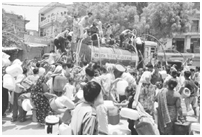Atul Sehgal?
After electricity, it”s water now Congress loot of the commoner?
 THE Delhi Jal Board is again in the news, for wrong reasons. This time, it is Aam Admi Party convener Arvind Kejriwal who has castigated DJB for effecting an 18 fold hike in water tariff. He accused the Delhi Govt. of effecting this sharp and steep hike in water tariff for camouflaging gross irregularities and corruption in DJB which are in the nature of a major scam of more than Rs. 10000 crore.
THE Delhi Jal Board is again in the news, for wrong reasons. This time, it is Aam Admi Party convener Arvind Kejriwal who has castigated DJB for effecting an 18 fold hike in water tariff. He accused the Delhi Govt. of effecting this sharp and steep hike in water tariff for camouflaging gross irregularities and corruption in DJB which are in the nature of a major scam of more than Rs. 10000 crore.
Privatisation of essential services like electricity and water supply has its own advantages or disadvantages for consumers depending on how effective and efficient the regulatory mechanism is and how honest is the controlling government in performing its mandated task and, last but not the least, how quick and effective is the judiciary in redressing consumers’ genuine grievances caused by gross irregularities on the part of private and government bodies involved in water distribution.
Transparency and fairness are the hallmark of a professional outfit. These essential attributes, therefore, are required of a government agency also because such agency is accountable to citizens in a democratic country. In a democracy, the rights of the consumers are of paramount importance. It is the bounden duty of the government to protect these rights. The term government here includes the executive and the judiciary. In the provision of basic amenities like electricity and water to the consumers, the government is obliged to make these essential items available at reasonable cost to the consumers. The role of quasi-judicial bodies called Regulatory Commissions is to rationalize the tariffs for these items so as to ensure their availability to all sections of the population at an affordable cost. Whether government bodies carry out the work of processing, storage and distribution of water or it is outsourced to private agencies by the former, the role of an independent regulator is very important here.
The tariff of water in Delhi has witnessed a huge increase from 2005 to 2010, evidenced by the rates of water consumption in different quantity slabs shown below:
It may be noted that the bulk of consumers belonging to the middle class and lower class sections of the society are using water in the above two slabs only. The moot question is – Has inflation or the cost of living or the cost of water as a commodity increased 15 times during the last 6 years to justify the above hike? No sane reasoning or argument can justify this except that it is the result of gross mismanagement including corruption. In a country where corruption has come to be regarded as a way of life, this should hardly surprise anybody. But what shocks the conscience of the ordinary citizen are the brazen lies that are spoken by the corruption ridden government agencies to justify such phenomenal hikes in water tariff.
Privatisation is the new mantra for hoodwinking the masses. In this country, privatisation has opened bigger flood gates to corruption. The water supply system in Delhi is beset with inadequacy and inefficiency and now, with outsourcing of water distribution to private agencies, the Delhi Government has already in-built an automatic 10% increase in water tariff every year, besides other intermittent hikes.
Private business house fleecing the consumers is understandable. But government bodies in collusion with the private business agencies exploiting the hapless, indigent consumers pains the citizen of democratic India no end.
Privatisation of water and power supply in UK was a dismal failure. The experience of privatisation of water and power in well regulated economies of the developed countries has been a mixed bag. This is because the business of distributing essential commodities like electricity and water needs to be properly regulated for optimisation of quantity , quality and cost from the consumers’ perspective. But what can be expected in underdeveloped, semi regulated and corruption ridden economy of India? Answers are best left to the imagination of the intelligent reader.
Slabs Rate in 2005 Rate in 2011
(Rs.) (Rs.)
10-20 kl/month 2 33 (16 times)
20-30 kl/month 7 83 (12 times)
?













Comments